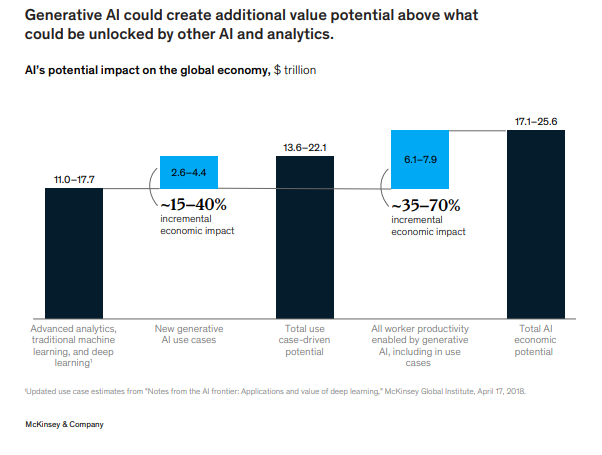🤖 Brace yourself: The AI jobs panic is about to explode
Two new reports suggest generative AI will have a big impact on knowledge workers. (And that's OK. Really.)
Quote of the Issue
"AI is an amplifier of human intelligence and when people are smarter, better things happen: people are more productive, happier, and the economy thrives." - Yann LeCun
The Essay
🤖 Brace yourself: The AI jobs panic is about to explode
While extreme AI doomers will no doubt continue to intensely focus on the supposed existential threat posed by generative AI, particularly large language models, I think concerns about job loss are ready to dominate the conversation on social media and coverage by traditional media outlets. My candidate for a key catalyst is a new report from the McKinsey Global Institute, “The economic potential of generative AI.” While The New York Times went with the upbeat “Generative A.I. Can Add $4.4 Trillion in Value to Global Economy, Study Says,” for a headline, this Bloomberg hed gives a hint of hysteria to come, “Biggest Losers of AI Boom Are Knowledge Workers, McKinsey Says.” I have a feeling that alarming angle is going to catch on. From Bberg:
The transformation will pile pressure on the labor force, especially for higher-wage knowledge workers whose activities “were previously considered to be relatively immune from automation,” the report said. A few years ago, McKinsey had estimated that about half of worker hours worldwide were spent on tasks that could be automated. Now it’s raising the figure to as high as 60-70%. Employees could find that their time is reallocated — or that their jobs disappear. “Workers will need support in learning new skills,” the report said. “Some will change occupations.”
Question: If new technologies can perform part of your current job (allowing you to do higher productivity and/or more creative tasks) or even your entire job — or to put it another way, tasks previously performed by labor to be produced by capital — are you a “loser?” Such framing equates any and all change with loss. If that were truly the case, workers have been losing for more than two centuries. Yet our current prosperity is built on disruption. Indeed, McKinsey estimates that the 63 use cases spanning 16 business functions for GenAI that it has identified could deliver $3 trillion to $4 trillion in global economic benefits. And that’s in addition to the $11 trillion to $18 trillion of economic value that McKinsey estimates nongenerative AI analytics could generate.
Then there are the potentially massive productivity gains: “Generative AI could enable labor productivity growth of 0.1 to 0.6 percent annually through 2040, depending on the rate of technology adoption and redeployment of worker time into other activities. Combining generative AI with all other technologies, work automation could add 0.2 to 3.3 percentage points annually to productivity growth.”
Industries rise and fall, jobs come and, the tasks performed in the production of products may change, sometimes favoring capital, other times labor. Such is economic history. But there’s a difference with generative AI, according to McKinsey, because of its ability to understand and use natural language for a variety of tasks … “particularly activities involving decision making and collaboration, which previously had the lowest potential for automation.”
Driving all of this is AI acceleration. MGI had previously identified 2027 as the earliest year when “median human performance for natural language understanding” might be achieved. But in this new analysis, the corresponding point is 2023. Now. From the report:
Keep reading with a 7-day free trial
Subscribe to Faster, Please! to keep reading this post and get 7 days of free access to the full post archives.






